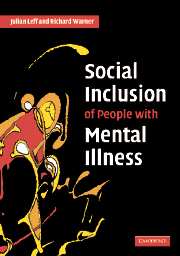Book contents
- Frontmatter
- Contents
- Preface
- 1 Introduction: barriers to social and occupational integration
- Part I The origins of stigma
- 2 The course of psychoses
- 3 The nature of stigma
- 4 Poverty and social disadvantage
- 5 Ameliorating users' symptoms
- 6 Dismantling psychiatric institutions
- 7 Reducing fear and discrimination among the public
- 8 Tackling self-stigmatisation
- Part II Overcoming obstacles to employment
- References
- Index
4 - Poverty and social disadvantage
from Part I - The origins of stigma
Published online by Cambridge University Press: 24 October 2009
- Frontmatter
- Contents
- Preface
- 1 Introduction: barriers to social and occupational integration
- Part I The origins of stigma
- 2 The course of psychoses
- 3 The nature of stigma
- 4 Poverty and social disadvantage
- 5 Ameliorating users' symptoms
- 6 Dismantling psychiatric institutions
- 7 Reducing fear and discrimination among the public
- 8 Tackling self-stigmatisation
- Part II Overcoming obstacles to employment
- References
- Index
Summary
The two populations of users
In discussing the effects of poverty and social disadvantage on people with severe psychiatric disorders, we need to distinguish between two populations. One population comprises those users who have spent a considerable period of time in psychiatric hospitals and have been resettled in the community. In developed countries that are phasing out psychiatric hospitals, this population is diminishing in size and will eventually become inconspicuous relative to the other population. This other population comprises those users who may have been admitted to psychiatric wards in general hospitals but who have never spent years of their life in institutions. Both populations may be subject to poverty and social disadvantage, but in the long-stay group these factors are compounded by the deleterious effects of institutional life on employment prospects, social networks and the accretion of stigma. These effects are interactive, since the stigma attached to a long admission to a psychiatric hospital weighs heavily against finding a job, lack of employment constrains finances and diminishes the possibility of expanding social networks, and years spent in an institution destroy existing social networks.
There is a new group of long-stay users emerging who spend over a year in the psychiatric wards of general hospitals. However, this experience is not comparable with decades incarcerated in an isolated psychiatric hospital that family and friends are reluctant to visit. The bulk of the literature on social networks relates to the traditional long-stay users, so we will consider them separately from current users.
- Type
- Chapter
- Information
- Social Inclusion of People with Mental Illness , pp. 41 - 52Publisher: Cambridge University PressPrint publication year: 2006
- 1
- Cited by

